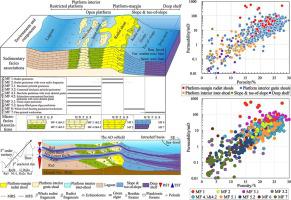Journal of Asian Earth Sciences ( IF 3 ) Pub Date : 2021-03-05 , DOI: 10.1016/j.jseaes.2021.104726 Hangyu Liu , Kaibo Shi , Bo Liu , Xinmin Song , Rui Guo , Genjiu Wang , Huan Wang

|
The Middle Cretaceous Rumaila Formation comprises a thick carbonate succession and forms an important reservoir unit in the Central Mesopotamian Basin. Microfacies analysis was performed based on the cores and thin sections observations to investigate the sedimentary and diagenesis evolution, and physical properties and mercury injection capillary pressure measurements were conducted to evaluate the reservoir quality. Ten microfacies types are identified showing that Rumaila carbonates deposited in five sedimentary facies belts: (i) platform-margin rudist shoals, (ii) platform interior grain shoals, (iii) platform interior inter-shoal, (iv) slope & toe-of-slope, and (v) deep shelf. These facies are organized into three regressive systems tracts and two transgressive systems tracts. Microfacies types present prominent vertical variations but are relatively stable in lateral extension, revealing a wide carbonate shelf sedimentary environment with frequent fluctuations of relative sea-levels. There is a good correlation between microfacies types and reservoir quality, ten microfacies types are classified as three classes with distinct reservoir quality. Thereinto, the microfacies rudist grainstone, bioclastic peloidal grainstone and worn rudist grainstone bear the best reservoir quality. The Rumaila Formation provides a typical case that reservoir quality and reservoir heterogeneity are jointly controlled by sedimentary facies variation caused by frequent relative sea-level changes, and differential early diagenesis. The frequent changes of relative sea-levels lead to the rapid changes of sedimentary facies (rock texture) and the frequently stacking of limestones with different primary porosity. Differential early diagenesis resulted in distinct contrasts of pore evolution for the same rock textures, which further enhance reservoir heterogeneity and also illustrate the destruction of cements on reservoir quality. This study provides an insight into reservoir quality prediction in the study area and other carbonate reservoirs undergone similar sedimentation and diagenesis process.
中文翻译:

伊拉克南部美索不达米亚盆地中部AD油田中白垩统Rumaila组的微相和储层质量
白垩纪中部鲁迈拉组由厚的碳酸盐岩层序构成,在美索不达米亚中部盆地形成了重要的储层单元。基于岩心和薄片的观测进行了微相分析,以研究沉积和成岩作用的演化,并进行了物理性质和注汞毛细管压力测量,以评价储层质量。识别出十种微相类型,表明鲁迈拉碳酸盐沉积在五个沉积相带中:(i)平台边缘的红土浅滩;(ii)平台内部的谷物浅滩;(iii)平台内部的浅滩间;(iv)坡度和趾间-坡度,以及(v)深层架子。这些相被组织成三个回归系统域和两个侵入系统域。微相类型表现出明显的垂直变化,但在横向扩展上相对稳定,揭示了一个宽碳酸盐层架沉积环境,且相对海平面经常波动。微相类型与储层质量之间具有良好的相关性,十种微相类型被划分为具有不同储层质量的三类。其中,微相鲁氏石,生物碎屑状砾岩和磨损的鲁氏石具有最好的储层质量。鲁迈拉组提供了一个典型的案例,储层质量和储层非均质性受频繁的相对海平面变化和早期成岩作用差异共同控制的沉积相变化共同控制。相对海平面的频繁变化导致沉积相(岩石质地)的快速变化以及具有不同原始孔隙度的石灰岩的频繁堆积。早期成岩作用的差异导致相同岩石质地的孔隙演化形成明显对比,这进一步增强了储层的非均质性,也说明了水泥对储层质量的破坏。这项研究为研究区和经历类似沉积和成岩作用的其他碳酸盐岩储层的储层质量预测提供了见识。这进一步增强了油藏的非均质性,也说明了水泥对油藏质量的破坏。这项研究为研究区和经历类似沉积和成岩作用的其他碳酸盐岩储层的储层质量预测提供了见识。这进一步增强了油藏的非均质性,也说明了水泥对油藏质量的破坏。这项研究为研究区和经历类似沉积和成岩作用的其他碳酸盐岩储层的储层质量预测提供了见识。



























 京公网安备 11010802027423号
京公网安备 11010802027423号